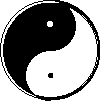 T'ai
Chi Collection
T'ai
Chi Collection Author Terry Chan to neijia list 21 Apr 1995
The kua has been translated as the inguinal canal and appears where the thigh joins the pelvis (i.e., the fold). If you can see and figure it where it is, play with some movement and you can probably readily see how open and close come into play with respect to it. Otherwise, if you're trying to figure it all out from words without any familiarity of where and what it physically is, good luck.
Author Bruce Wolfe to neijia list 21 Apr 1995
I believe Terry has it right for the most part on the kua question. This is where the opening and closing is most important for directing and lining up the integration with the earth. It is here and then up to the ming men that most have trouble making the connection with the earth. The next place is between the shoulder blades and out the fingers. Another kua to remember is the upper kua inside of the shoulders. If you keep in mind the 6 harmonies - shoulders to hips;elbows to knees; wrists to ankles - it makes foreasier integration. And, pushing the wall is definitely a fundamental and important practice. This is the first thing I learned from Fong upon arrival and after nearly two solid months of trying to move that damn wall it was clear that wall was pushing me back into my root if I got the alignment correct. Otherwise, the wall *bounced* me away. Kudos to the teacher who taught you that. This is a significant component of the yiquan system to teach integration.
Author Charles Tauber to neijia list 21 Apr 1995
So, if you want to know what exactly kua is,... An example, if your shoulder is being pushed back, the hip must rotate accordingly and your kua will open like a door.
To clarify, the kua on the opposite side of the body from the shoulder being pushed - as demonstrated in the movement roll-back. No?
Author Allen Chen to neijia list 22 Apr 1995
If you are referring the kua as the entire rounded area of inner thigh from the knees to the groin, then I think there is only one kua, and it is either open or close. This opening and closing is powered by the rotation of one hip joint pivoting on the other. When, say your left shoulder is pushed, you first establish the peng path from the shoulder all the way to the rooted foot (in the List's preferred terminology), be it left foot or right foot. Then when you redirect the push, you pivot on the *right* hip joint and rotate your *left* hip joint *backwards*, which moves your left shoulder, which neutralizes the incoming push. At this point, you will find your kua open.
As to the roll back posture, like in the single hand pushing hand of alternating Lu/An, not only should the motion of the hand be driven by the opening of the kua, as Mike have said it should also be driven by a whole-body contraction towards the root.
 T'ai
Chi Collection
T'ai
Chi Collection |
Sponsor |